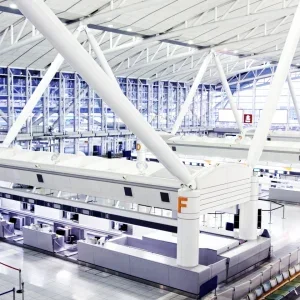Groningen Airport Eelde was the first project partner to benefit from the Green Sustainable Airports (GSA) alliance. The airport’s runway extension, completed in April 2013, was a paragon of sustainability, reducing carbon by 24% compared with similar projects and saving almost 140,000t of raw materials. For example, the electricity required during the work process was sourced from wind energy, and the taxilights and signs are lit with LED lighting.
In addition, the soil required for raising the level of the runway is ‘ground ash’ from a local recycling installation, while the runway was not topped with the usual tar surface but with an innovative and much more environmentally friendly material called SMA-plus. Groningen Airport Eelde is one of the first airports in Europe to have such a runway surface.
As a result of the extended take-off and landing strips, more flight traffic is expected. However, the environmental impact of each flight can still be reduced because during landing the aircraft do not need to use full motor power when braking. Moreover, many departure flights can lift off with reduced power, a so-called ‘de-rated take-off’.
Finally, a longer runway means that more flights – to southern-European countries, for example – can be carried out without an intermediate landing, resulting in fuel and noise reduction.
Continuous descent approach
Within the scope of GSA, Groningen Airport Eelde has introduced continuous descent approach (CDA) to the airport. A CDA is an aircraft operating technique whereby an arriving aircraft descends from an optimal position with minimum thrust, while avoiding level flight. CDA saves fuel
and also reduces aircraft noise and atmospheric emissions in the vicinity of the airport, resulting in environmental and economic advantages. Currently, all commercial flights adopt this ‘glide-landing’ technique. It is expected that other regional airports will follow this example of CO2 reduction.
There are further examples of CO2 reduction within the GSA project:
- Billund Airport is developing a new system for heating and cooling aircraft based on green technology. Initial results of its analyses show that by using this new technology, a CO2 reduction of 80% can be achieved.
- Bremen Airport has initiated a study, involving all partners, to find ways to avoid noise while the aircraft is on the ground. The noise can be reduced by using protection walls or hangars, or by choosing an area that is less noise-sensitive.
- As well as at Groningen, LED lighting is being tested on taxiways and runways at Billund and London Southend Airports.
- Energy-efficiency studies in airport buildings are being carried out at Billund, London Southend and Kortrijk-Wevelgem. Kent County Council in the UK is leading the research on improving green public transport to and from the partnership’s airports, while Bremen is testing integrated travel information from airliners and public transport.
Really sustainable?
Within the GSA project, there’s a realistic perspective that sustainable aviation is not yet within reach and that flying still poses a strain on surroundings and the environment. That does not mean there is nothing to achieve, and GSA is making good headway. The exact environmental gains are difficult to calculate, but each step towards greener airport operations is of great value.
GSA is made possible with help of the Interreg IVB North Sea Region Programme and the EU.
Further information: Groningen Airport Eelde www.greenairports.eu




